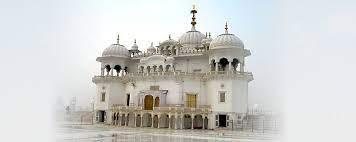Takhat Keshgarh Sahib:
Takhat Keshgarh Sahib is one of five takhat of the Sikhs. This takhat is the main and the biggest Gurdwara in Anandpur Sahib. It was here that the khalsa was born at Baisakhi time 1699, when the first Five Sikhs to be given the name Singh, namely the Panj Pyara's came forward with dedication and the Khalsa Panth was initiated, with the inception of Khalsa caste distinction evaporated and Singh's emerged. The Guru himself was the first to recieve Pahul from the first five pyaras. Seeing this kindled the minds of the people to take the Guru's gift of Amrit and become Khalsa Saint-Soldiers, as well. Many weapons of Guru Gobind Singh ji are kept here as a treasure.
Gurdwara Mata Jito: Gurdwara Mata Jito Ji is dedicated to Mata Jito Ji, wife of Guru Gobind Singh and mother of Sahibzadas Jujhar Singh, Zorawar Singh and Fateh Singh. She died in December 1700 and was cremated at this place just outside Agampur village two killometres northwest of Anandpur Sahib.
Gurdwara Nirmohgarh: Nirmohgarh is the name given by chroniclers to a hilly tract south of Kiratpur Sahib where a battle took place between Guru Gobind Singh and hill chiefs who were supported by a strong contingent of Mughal troops equipped with cannons. The battle was fought in two phases. On 7th October 1700, the hill chiefs attacked the Guru's positions but the attack was repulsed. Then they requisitioned imperial troops from Sirhind and on their arrival they encircled the Sikhs and launched another attack on the 12th of the same month in which they, at least once, directed cannon fire at the Guru himself. Guru Gobind Singh escaped unhurt but his attendant, Bhai Ram Singh was killed. The Guru returned the fire with an arrow-shot which made short work of the cannoneer. On the 13th, the Guru and his warriors broke the encirclement and crossed the Sutlej to reach Basali, a friendly principality.
Takhat Keshgarh Sahib is one of five takhat of the Sikhs. This takhat is the main and the biggest Gurdwara in Anandpur Sahib. It was here that the khalsa was born at Baisakhi time 1699, when the first Five Sikhs to be given the name Singh, namely the Panj Pyara's came forward with dedication and the Khalsa Panth was initiated, with the inception of Khalsa caste distinction evaporated and Singh's emerged. The Guru himself was the first to recieve Pahul from the first five pyaras. Seeing this kindled the minds of the people to take the Guru's gift of Amrit and become Khalsa Saint-Soldiers, as well. Many weapons of Guru Gobind Singh ji are kept here as a treasure.
Gurdwara Mata Jito: Gurdwara Mata Jito Ji is dedicated to Mata Jito Ji, wife of Guru Gobind Singh and mother of Sahibzadas Jujhar Singh, Zorawar Singh and Fateh Singh. She died in December 1700 and was cremated at this place just outside Agampur village two killometres northwest of Anandpur Sahib.
Gurdwara Nirmohgarh: Nirmohgarh is the name given by chroniclers to a hilly tract south of Kiratpur Sahib where a battle took place between Guru Gobind Singh and hill chiefs who were supported by a strong contingent of Mughal troops equipped with cannons. The battle was fought in two phases. On 7th October 1700, the hill chiefs attacked the Guru's positions but the attack was repulsed. Then they requisitioned imperial troops from Sirhind and on their arrival they encircled the Sikhs and launched another attack on the 12th of the same month in which they, at least once, directed cannon fire at the Guru himself. Guru Gobind Singh escaped unhurt but his attendant, Bhai Ram Singh was killed. The Guru returned the fire with an arrow-shot which made short work of the cannoneer. On the 13th, the Guru and his warriors broke the encirclement and crossed the Sutlej to reach Basali, a friendly principality.
Takhat Keshgarh Sahib:
Takhat Keshgarh Sahib is one of five takhat of the Sikhs. This takhat is the main and the biggest Gurdwara in Anandpur Sahib. It was here that the khalsa was born at Baisakhi time 1699, when the first Five Sikhs to be given the name Singh, namely the Panj Pyara's came forward with dedication and the Khalsa Panth was initiated, with the inception of Khalsa caste distinction evaporated and Singh's emerged. The Guru himself was the first to recieve Pahul from the first five pyaras. Seeing this kindled the minds of the people to take the Guru's gift of Amrit and become Khalsa Saint-Soldiers, as well. Many weapons of Guru Gobind Singh ji are kept here as a treasure.
Gurdwara Mata Jito: Gurdwara Mata Jito Ji is dedicated to Mata Jito Ji, wife of Guru Gobind Singh and mother of Sahibzadas Jujhar Singh, Zorawar Singh and Fateh Singh. She died in December 1700 and was cremated at this place just outside Agampur village two killometres northwest of Anandpur Sahib.
Gurdwara Nirmohgarh: Nirmohgarh is the name given by chroniclers to a hilly tract south of Kiratpur Sahib where a battle took place between Guru Gobind Singh and hill chiefs who were supported by a strong contingent of Mughal troops equipped with cannons. The battle was fought in two phases. On 7th October 1700, the hill chiefs attacked the Guru's positions but the attack was repulsed. Then they requisitioned imperial troops from Sirhind and on their arrival they encircled the Sikhs and launched another attack on the 12th of the same month in which they, at least once, directed cannon fire at the Guru himself. Guru Gobind Singh escaped unhurt but his attendant, Bhai Ram Singh was killed. The Guru returned the fire with an arrow-shot which made short work of the cannoneer. On the 13th, the Guru and his warriors broke the encirclement and crossed the Sutlej to reach Basali, a friendly principality.
0 Comentários
0 Compartilhamentos
0 Anterior




